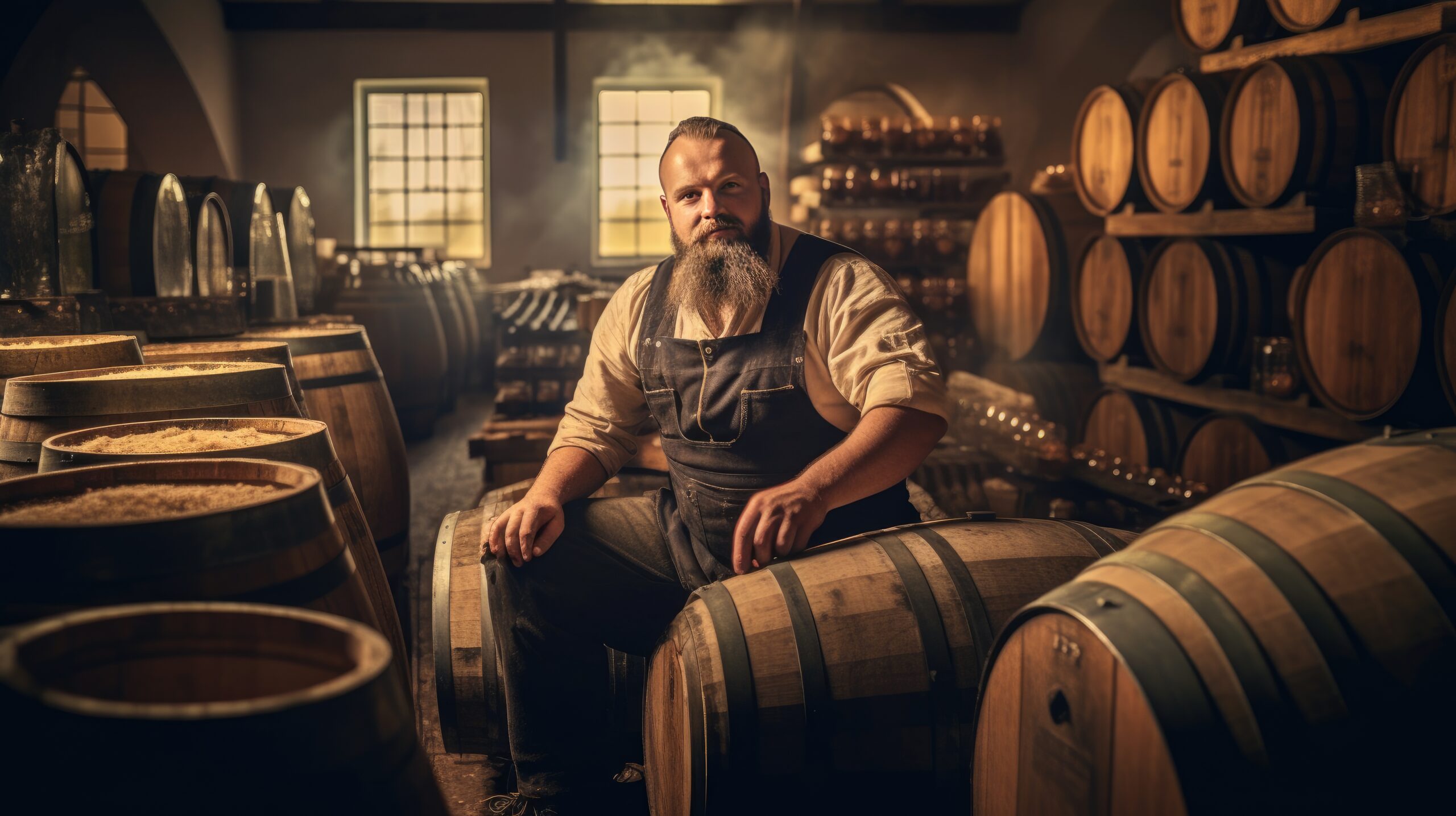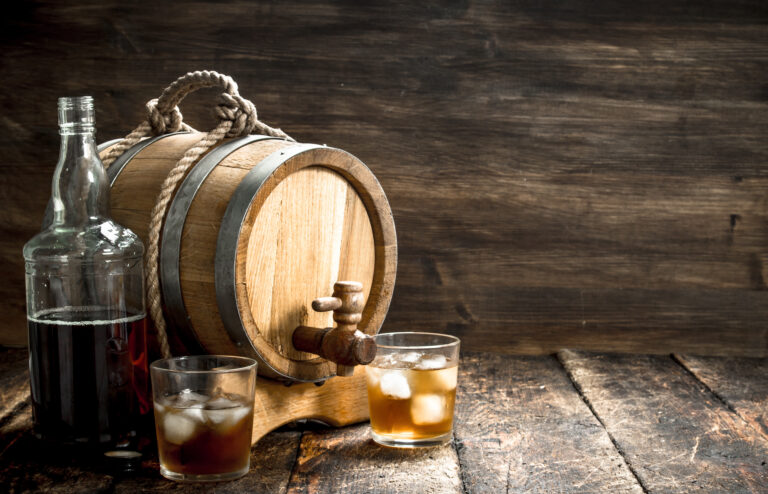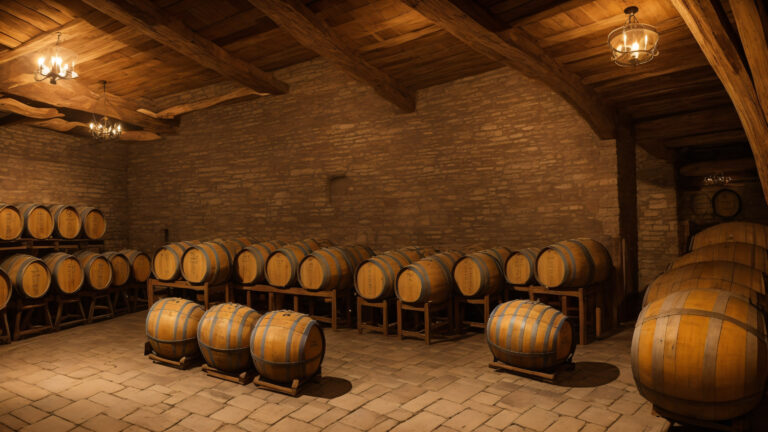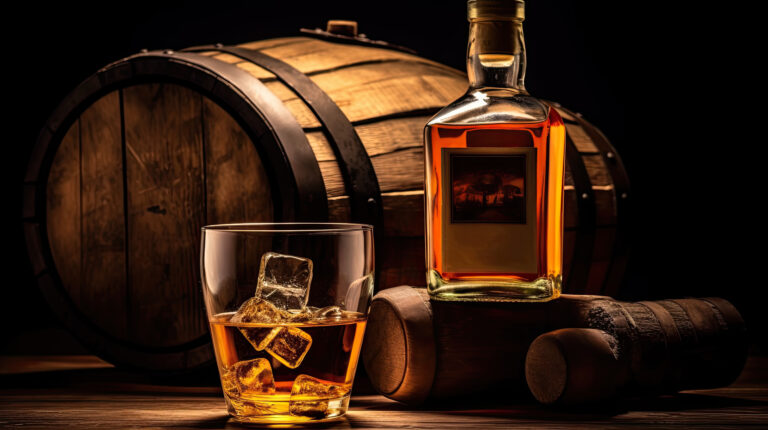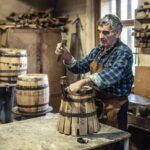You know, there’s nothing quite like a good whiskey. But have you ever stopped to wonder how it gets that incredible, complex flavor? It’s not just magic, it’s all thanks to the barrel aging process and how distilleries meticulously manage their barrel filling strategies. As whiskey matures in those beautiful charred oak barrels, it pulls in amazing notes like caramel, vanilla, and a hint of spice directly from the wood.
But here’s the kicker: distillers aren’t just filling barrels whenever the mood strikes. They’re actually working in harmony with the seasons to coax out the very best flavors. Filling barrels in the winter allows for a slower, more deliberate aging, while a summer fill can really kick the maturation process into high gear. These seasonal temperature swings are crucial, affecting how quickly the whiskey interacts with the wood. When it’s warm, the whiskey expands, diving deeper into the oak and soaking up more of those coveted flavors. Colder weather, on the other hand, causes the whiskey to contract, slowing down the whole affair. By smartly using seasonal barrel filling, distilleries gain incredible control over their whiskey’s aging profile, aiming for that perfect balance of flavors. For those truly exceptional whiskeys, master distillers are practically weather whisperers, knowing just the right moment to fill their barrels.
So, the next time you savor a glass of beautifully aged whiskey, take a moment to appreciate the incredible thought and care that went into barreling it at precisely the right season. It’s a testament to how distillers worldwide collaborate with the rhythms of nature to craft spirits that genuinely stand the test of time.
The Importance of Seasonal Barrel Filling for Whiskey
The seasons play a profound role in how whiskey ages in barrels. For distillers, choosing the ideal time of year to fill those barrels is absolutely vital for developing the perfect flavor profiles.
- Spring: As the weather starts to warm up, the wood in barrels expands, allowing the whiskey to really penetrate deep into its structure. This means more oak tannins and a spicier, fuller flavor. Whiskeys barreled in spring might just need a little extra time to truly mellow out.
- Summer: The hot summer months lead to increased interaction between the whiskey and wood due to higher evaporation. This often results in a darker, richer spirit, boasting lovely notes of vanilla and caramel. However, be careful – too much heat can actually over-age the whiskey, leading to an unwanted bitter taste. Close monitoring of barrel temperature is key here.
- Fall: Cooler fall weather causes the barrel to contract, slowing down the aging process. Whiskey filled in autumn might require several extra years to reach its full potential, but it often develops a wonderfully balanced, smooth flavor with delightful hints of dried fruit.
- Winter: Frigid winter temperatures almost bring the aging process to a halt. Barrels filled in winter can take significantly longer to mature, but they produce a lighter, more mellow spirit. The cold also acts as a natural safeguard against over-aging, truly allowing the whiskey’s inherent character to shine through.
By understanding these seasonal temperature changes and their effects, distillers can pinpoint the perfect time to fill their barrels, depending on the specific flavor profile they’re chasing. With patience and meticulous care, properly executed seasonal barrel filling is the secret to a truly distinguished whiskey.
Spring Barrel Filling Considerations
Spring isn’t just about new blossoms; for distilleries, it’s a prime time to fill those barrels for aging whiskey. The spring barrel filling season comes with some important things to keep in mind.
With the weather warming up, the wood in your barrels will be expanding. This means the wood’s pores are opening wider, allowing the whiskey to penetrate even deeper. The result? More flavor and aroma compounds making their way into your spirit. However, with this expansion, you’ll also need to factor in a higher angel’s share – that’s the amount of liquid lost to evaporation. You might even need to slightly overfill barrels to account for that increased loss.
You’ll also find higher humidity and rain in many regions during spring. This extra moisture in the air can actually seep into the barrels, subtly diluting the whiskey inside. So, ensure your barrel storage location is super well-ventilated and thoroughly protected from any excess moisture. A dedicated barrel warehouse is definitely the ideal setup.
Another crucial factor is seasonal temperature variations. Larger temperature swings, especially common in spring, mean the whiskey will be moving in and out of the wood at a faster rate. This can lead to the spirit absorbing wood flavors more quickly. You might find yourself needing to check on your barrels more often, and perhaps even emptying some barrels sooner than anticipated.
New oak barrels, in particular, are quite aggressive in imparting flavor and aroma compounds. If you’re using new oak barrels, make sure to conduct regular tasting trials to determine if the spirit has absorbed enough oak character before you consider moving it to second-fill barrels for continued aging.
By considering these seasonal and environmental factors when filling and managing your barrels in spring, you can ensure your whiskey develops wonderfully balanced, not overpowering, wood notes. The rewards of spring do come with extra responsibilities, but with careful monitoring and timely adjustments, you’ll end up with a truly delicious final product.
Strategies for Summer Barrel Filling
Summer is an incredibly opportune time for barrel filling at whiskey distilleries. The warm weather actively helps the barrels expand, allowing the whiskey to truly penetrate the wood grain. Here are some excellent tips for summer barrel filling:
Choose the Right Barrels
For bourbon, it’s a no-brainer: always opt for new charred oak barrels. The fresh wood provides a powerhouse of flavor to the whiskey during those hot summer months. For other types of whiskey, consider using used barrels that previously held sherry, port, or wine. The delightful residual flavors from these barrels will absolutely shine through strongly in the summer heat.
Fill Barrels at the Right Level
Whatever you do, don’t overfill your barrels in summer. As the temperature rises, the whiskey will naturally expand. Make sure to leave some headspace, ideally around 3% to 5%, to prevent the barrel from bursting. And remember to check barrel levels regularly, removing any excess whiskey if needed.
Location Matters
Place your barrels in a spot that maintains a truly consistent temperature, well away from direct sunlight. A room or warehouse with excellent ventilation and airflow will help keep temperatures moderate. Steer clear of drafty or uninsulated spaces where temperatures can wildly fluctuate, as this can put unnecessary stress on your barrels.
Rotate and Monitor
Make it a point to rotate and move your barrels around the storage area to ensure they mature evenly. Double-check that barrels are still properly sealed, as the heat can unfortunately cause leaks and increased evaporation. And most importantly, taste and test the whiskey regularly! The warm weather will cause the whiskey to interact quickly with the barrel, so you really need to monitor flavor development closely.
Consider Single Barrel Bottling
If you’re aiming to bottle a single barrel release, summer might just be the perfect time. The sped-up maturation in the heat can lead to an expression with a truly distinct, robust character that stands out magnificently on its own. The whiskey in a single barrel will develop at its own unique pace, creating a one-of-a-kind product.
By following these practical strategies, you can effectively harness the summer heat and use it to craft memorable, full-flavored whiskeys. Careful barrel management and diligent monitoring can lead to an expression that truly embodies the vibrant essence of the summer season.
How to Approach Fall Barrel Filling
Fall is always a buzzing time for whiskey distilleries, as the weather cools and barrels can be efficiently filled in preparation for aging through the winter. As a distiller, there are a few crucial strategies to keep in mind when you’re filling barrels in the autumn.
Choose Your Barrels Wisely
The type of barrel you select profoundly impacts the flavor of the final whiskey. For fall filling, medium char barrels made of American white oak are a hugely popular choice. They naturally impart those comforting notes of vanilla and caramel that wonderfully complement the rich, warm flavors of the season.
Consider the Whiskey’s Age
The length of time a whiskey will age is entirely dependent on the type of whiskey being produced. Bourbons and ryes typically age for 2 to 5 years, while single malts can age for a remarkable 10-30 years or even longer. Filling barrels in the fall is ideal for maximizing aging during the cooler months. The natural temperature changes and the wood’s contraction over winter truly help the whiskey penetrate deeper into the barrel.
Evaluate the Weather
Cooler weather means your barrel filling process will run much more efficiently. Distilling equipment generally operates best in temperatures between 50-70°F (10-21°C). Fall’s crisp, comfortable weather is absolutely perfect for the manual labor involved in filling and moving barrels. Plus, your workers will be safer and happier in that cool autumn air!
Prepare for Seasonal Flavors
Whiskeys aged in barrels filled during autumn often take on delightful notes reminiscent of the season, like cinnamon, nutmeg, clove, and maple. These warm, spicy flavors are imparted to the whiskey through its contact with the wood and the process of oxygenation during aging. Fall-filled barrels can truly produce whiskeys with an extra layer of seasonal depth and a distinctive character.
By implementing these effective strategies, you’ll make the absolute most of fall barrel filling and set your whiskey up to become a deliciously complex, full-flavored spirit. With the right wood and optimal aging time, your autumn barrels can yield a whiskey as cozy and flavorful as the season itself.
Winter Barrel Filling Tips and Tricks
Filling barrels in the winter definitely calls for some special considerations to ensure the whiskey ages properly during those colder months. Here are some essential tips and tricks to keep in mind:
Temperature Control
The sweet spot for whiskey barrel aging is generally between 65 to 72 degrees Fahrenheit (18-22°C). In the winter, you’ll need to monitor barrel temperatures very closely since ambient temperatures will naturally drop. Consider using a barrel heater with a thermostat to automatically turn it on and off as needed, keeping temperatures consistently in that target range. And always check barrel temperatures regularly to ensure your heating system is doing its job.
Humidity
Lower winter humidity levels can unfortunately cause barrels to dry out, leading to excessive evaporation and a loss of volume. Combat this by using a humidifier in your barrel storage area to maintain relative humidity between 55% to 65%. This humid environment will also help the wood in the barrels stay swollen, keeping the barrels nice and tight.
Rotation
Continue rotating your barrels during the winter, though perhaps slightly less frequently than in warmer months. Rotating barrels helps the whiskey age evenly by exposing all sides of the barrel to subtle temperature variations. In the winter, rotating barrels every 4 to 6 weeks should be sufficient.
Sampling
Don’t stop sampling barrels in the winter! It’s crucial to continue monitoring how the whiskey is aging and maturing. The slower aging process in colder temperatures can often produce some truly interesting flavor changes. Make sure to taste barrels that were filled at different times to compare how those temperature variations impact their aging.
Safety
Always exercise caution when working in the barrel warehouse during winter. Wet, icy floors can be extremely slippery, and space heaters pose a fire risk if not properly ventilated and monitored. Always follow all standard safety procedures to prevent injury or damage.
With close monitoring and a few seasonal adjustments, your barrels can continue aging safely through the winter. The slowed aging during colder temperatures often results in whiskeys with distinctive flavor profiles. Staying on top of temperatures, humidity, rotation, sampling, and safety will ensure your winter barrels produce the absolute best whiskey.
The Impact of Climate on Barrel Filling Decisions
The climate and weather have a massive influence on barrel filling decisions for whiskey distilleries. As the seasons roll through, so do critical factors like temperature, humidity, and barometric pressure – all of which significantly affect how whiskey matures in barrels.
Temperature
The temperature of the aging warehouse directly impacts how quickly chemical reactions occur within the barrel. Warmer temperatures accelerate these reactions between the whiskey and the barrel, causing the whiskey to mature faster. Conversely, colder temperatures slow these reactions down. Many distilleries strategically fill more barrels in winter or early spring so the whiskey has the maximum possible time to age during the warmer summer months.
Humidity
Humidity refers to the amount of moisture in the air. Higher humidity encourages the whiskey to extract more flavor compounds from the barrel, especially those desirable oak lactones that impart vanilla and coconut notes. When humidity is lower, less interaction happens between the whiskey and the barrel. Some distilleries aim for a seasonal balance by filling more barrels in summer when humidity is naturally higher, and fewer barrels in winter when the air tends to be drier.
Air Pressure
Barometric pressure, or air pressure, directly impacts how much whiskey evaporates from the barrel during aging – what’s famously known as the “angel’s share”. Lower air pressure allows more evaporation to occur. Many distilleries wisely avoid filling barrels when a low-pressure weather system is approaching, as a larger angel’s share means less whiskey left in the barrel to age and develop those crucial flavors.
By thoughtfully considering how climate and weather influence barrel maturation, whiskey distilleries can make truly strategic barrel filling decisions. Filling more barrels during ideal conditions means maximizing flavor development and ensuring the absolute best possible product. While no distillery can completely control the weather, understanding and working with seasonal changes consistently leads to superior aged whiskeys.
Optimizing Warehouse Conditions for Seasonal Barrels
Optimizing the conditions within your whiskey warehouse can have a profound impact on the quality of your seasonal barrel fills. Paying meticulous attention to factors like temperature, humidity, and airflow will ensure your whiskey truly reaches its full potential.
Temperature is undoubtedly one of the most critical elements. The ideal range for whiskey aging is generally between 55 to 65 degrees Fahrenheit (13-18 degrees Celsius). Colder temperatures will slow down the aging process, while warmer temperatures can unfortunately speed it up too much and impart undesirable off-flavors. Use temperature monitors to constantly track conditions, especially during the crucial first few years of aging.
Humidity is equally important. Most distilleries aim for 65% to 80% relative humidity in the warehouse. Too much humidity can lead to problematic mold growth, while overly low humidity causes excessive evaporation and a significant loss of flavor. Circulation fans and proper ventilation are key to regulating humidity and preventing stale air.
Proper airflow is vital; it allows the whiskey to “breathe,” effectively absorbing flavors from the wood. Inadequate airflow prevents this essential interaction and can result in lackluster flavor. Barrels should always be spaced apart, with ample room for air to circulate freely around each one.
Choose a warehouse location well away from strong odors that could impart unwanted off-notes to the whiskey. Remember, barrels are porous, meaning they’ll absorb surrounding aromas. Also, locate warehouses in a quiet, sheltered area, far from heavy vibrations that could disrupt the delicate aging process.
By adhering to these best practices for optimizing warehouse conditions, you’ll help ensure your seasonal barrel fills develop into truly memorable, distinctive whiskeys. Pay close attention, especially in those early years, and make adjustments as needed to provide the ideal environment for your whiskey to age and mature perfectly. With the right balance of temperature, humidity, airflow, and location, your seasonal barrels are destined to become noteworthy, flavorful spirits.
Tasting and Blending Considerations for Seasonal Barrels
When you’re figuring out how to blend your seasonal whiskey barrels, several factors really come into play. The unique characteristics of the barrels themselves, along with the properties of the distillate, all directly affect the final flavor profile. You’ll want to consider these elements carefully to create a harmonious and balanced blend.
Wood Type
The type of wood used for the barrels impacts flavor in a huge way. Oak barrels, especially American white oak, are the most common for whiskey, adding those classic vanilla and caramel notes. Barrels made of maple, hickory, or chestnut wood, however, will impart distinctly different flavors. Mixing wood types in a blend can definitely create complexity, but it can also muddle the flavor if not done very judiciously.
Toast Level
The toast level refers to how charred the inside of the barrel is. A lighter toast produces subtler flavors, while a heavier char imparts more pronounced smoky notes. Blending barrels with different toast levels allows you to perfectly balance the intensity of flavor in your final product.
Age
The age of the whiskey in each barrel determines crucial characteristics like smoothness, aroma, and depth of flavor. Blending younger and older barrels creates a beautiful balance of freshness and maturity. As a general rule of thumb, the age of the youngest barrel in the mix sets the age statement for the entire blend.
Distillate
The properties of the distilled spirit before it even touches the barrel also play a significant role in the blend. Distillate from the heart of the run will have a fuller, rounder flavor than what’s found in the “heads” or “tails.” The goal of your blend should always be to showcase the very best qualities of that original distillate.
Proof
The barrel proof, or alcohol percentage, impacts both flavor intensity and mouthfeel. Blending barrels of higher and lower proof allows for precise adjustment of these attributes to create the perfect balance for your desired whiskey profile.
By thoughtfully combining barrels of different ages, wood types, toast levels, distillates, and proofs, a master distiller truly crafts a whiskey that is greater than the sum of its individual parts. The real art lies in achieving harmony between sometimes disparate elements. With careful attention and seasoned experience, you can create a whiskey blend with amazing seasonal character that still feels completely unified.
FAQs on Seasonal Barrel Filling Strategies for Whiskey Distilleries
As a whiskey distillery, you’re always striving for the best barrels to age your spirits, but sourcing high-quality barrels at just the right time can be quite a challenge. Here are some practical strategies to consider for seasonal barrel filling:
- Plan Ahead: Don’t wait until the last minute to source your barrels. Work proactively with cooperages 6-12 months in advance to ensure barrel availability and secure the best prices. Always forecast how many barrels you’ll need based on your production schedules.
- Buy in Bulk: If it’s feasible, definitely buy barrels in larger quantities. This often allows cooperages to offer better pricing and ensures you have enough barrels on hand for all your needs. You’ll also save significantly on shipping costs. Just make sure you have adequate storage space for bulk purchases.
- Consider Alternate Wood Types: Beyond the usual oak barrels, explore other wood types that can uniquely influence flavor, such as hickory, maple, or chestnut. These woods can impart distinct tastes that really set your whiskey apart. However, be aware that less common woods may be more difficult to source and can be more expensive.
- Vary Toast and Char Levels: Don’t stick to the same barrel toast and char levels for every single batch of whiskey. Mixing up the levels will create much more complex flavors in your aged spirits. For instance, use barrels with a heavy char for one batch, a medium toast for another, and a light toast for a third. This variety will lead to a more compelling final product.
- Reuse Barrels: Don’t dismiss the idea of reusing barrels that have already aged whiskey or other spirits. As barrels are reused, they naturally lose some of their intense oakiness, which allows other subtle flavors to shine through. Reusing barrels a few times before replacing them also helps your bottom line.
By planning ahead, buying in bulk when possible, exploring different wood types, varying barrel toasts, and cleverly reusing barrels, you’ll set yourself up for significant success with your barrel filling strategies. These steps will ensure you have high-quality, well-sourced barrels on hand for all your production needs. Your aged spirits will undoubtedly benefit from the nuanced, complex flavors that only the right barrels can truly provide.
Final Thoughts
So there you have it – some really practical tips and tricks for smart seasonal barrel filling for your whiskey. Don’t just fill barrels haphazardly; put some real thought into it! Consider the seasons, those subtle yet powerful temperature changes, and how those fluctuations can profoundly impact your whiskey’s flavor as it ages. Think about different oak varieties and toast levels to perfectly match the season. And whatever you do, don’t forget to account for the angel’s share and regularly sample your barrels so you end up with precisely the flavor profile you’re dreaming of. Barrel filling might seem straightforward, but following these seasonal strategies will genuinely help ensure you produce an truly exceptional aged spirit. Now, get to work filling those barrels – your future whiskey is waiting!
